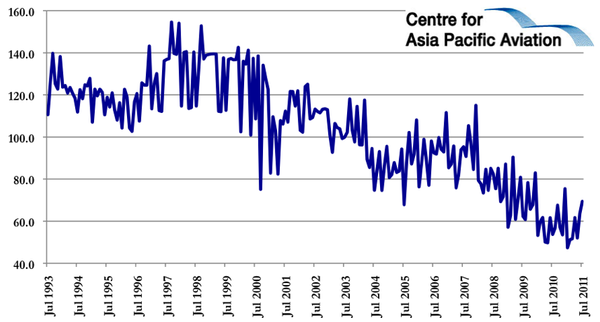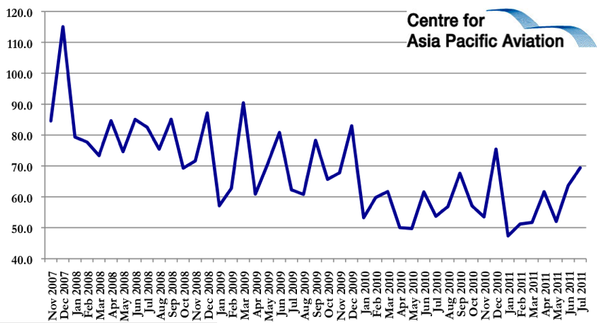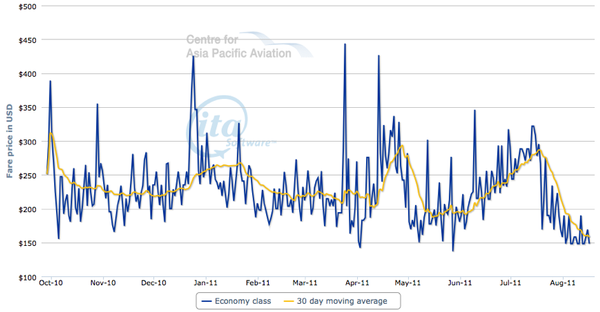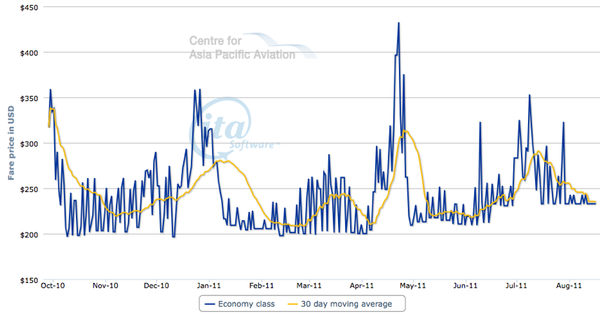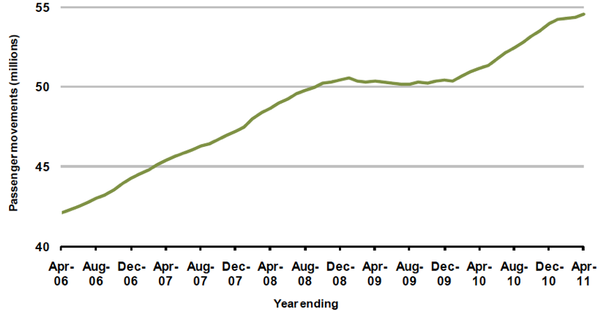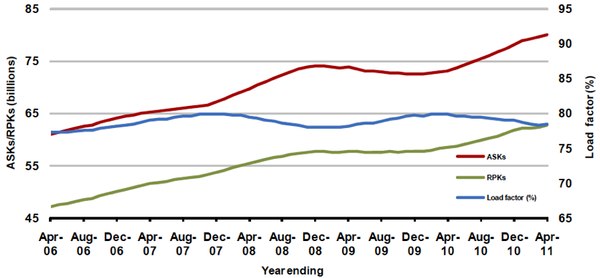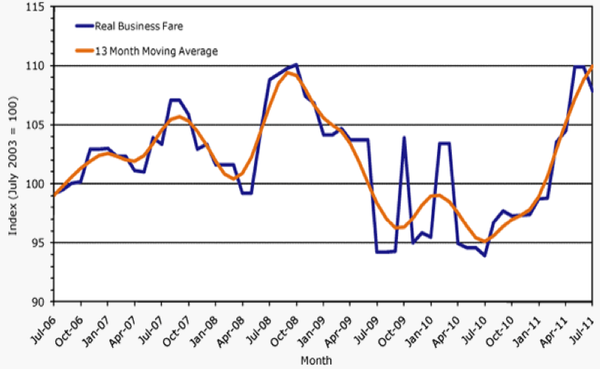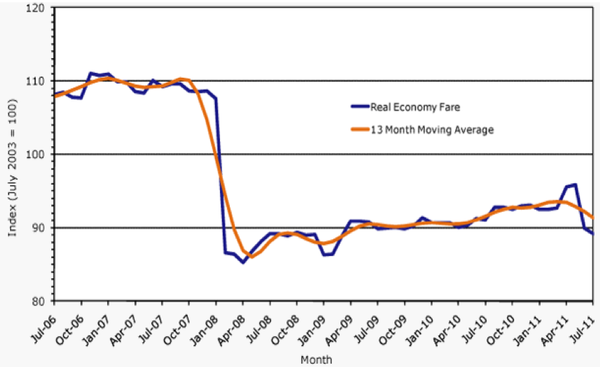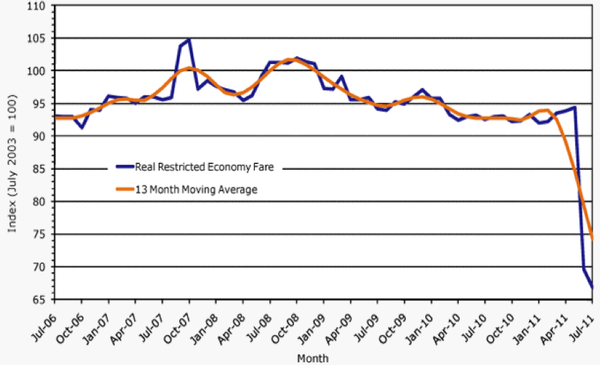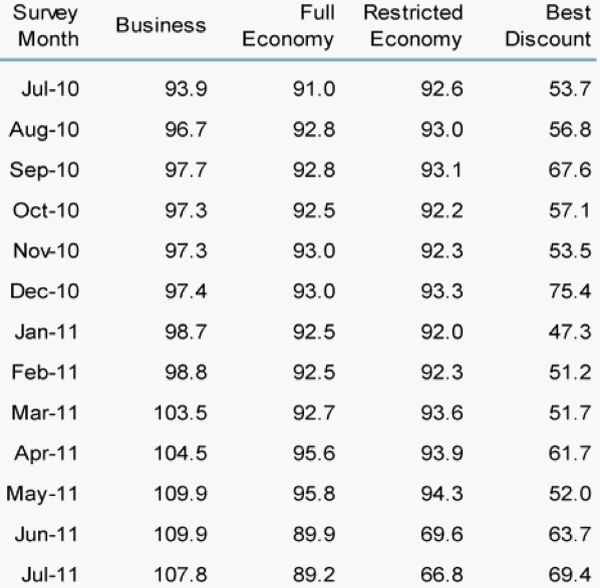Australian domestic airfares soar amid Tiger Airways Australia suspension
Australia's best discount (cheapest) domestic fares surged 29% in Jul-2011, typically a weaker winter low season in Australia, to the highest level of 2011 in the same month that saw the unprecedented grounding of Tiger Airways Australia. The figures support concerns that the grounding of Tiger Airways Australia for "systemic" safety concerns is creating a substantial upward pressure on airfares.
Australia domestic air fares (best discount): Jul-2006 to Jul-2011
In other bad news for Australian consumers, the Australian Government this week announced that effective 01-Jul-2012, domestic aviation fuel excise will be increased by an amount equivalent to the carbon price of AUD23 (USD21.40) per tonne on an annual basis over the fixed price period to "provide an effective carbon price for aviation", according to government papers. Qantas and Virgin Australia have stated they would pass on the cost to consumers, resulting in average domestic fare increases per sector of approximately AUD3.00 to AUD3.50.
See related article: Australia puts a AUD23 per tonne price on carbon; airlines to be hit hard
Best discount fares up 11% from Jul-2009 levels but 27% below Jul-2007 levels
Australia's Bureau of Infrastructure, Transport and Regional Economics (BITRE), in its Domestic Air Fare Index for Jul-2011, stated the Best Discount Fare Index (Jul-2003=100) for domestic air travel increased strongly 29.2% year-on-year to 69.4. Best discount fares in Jul-2011 were up 11.4% from Jul-2009 levels but are 15.9% below Jul-2008 and 27.2% below Jul-2007 levels, prior to the launch of Tiger Airways Australia in Nov-2007.
Australian domestic best economy Air Fare Indexes: Jul-1993 to Jul-2011
Tiger Airways Australia has positive impact on Australian fares for consumers
The competitive landscape in the domestic market has changed significantly over the past decade. The Australian domestic market was a duopoly until the entry of Virgin Blue in Aug-2000. With the collapse of Ansett in Sep-2001, Virgin Blue (now Virgin Australia) quickly became Australia's second major domestic airline. Qantas' LCC, Jetstar, was established in 2003 to counter the impact of Virgin Blue and as part of efforts by Qantas to maintain a 65% domestic market share.
The landscape changed again notably with the entry of Tiger Airways Australia into the market in Nov-2007 as an aggressive entrant looking to undercut Virgin Blue and Jetstar with even cheaper fares. The entrance of Tiger contributed to considerable downward pressure on prices in the market, as highlighted by the BITRE fare data.
Australia domestic air fares (best discount): Nov-2007 to Jul-2011
Over its time in the market, Tiger Airways established its price-leadership position with the carrier continuing to offer reduced airfares throughout 2010 and into 2011. Tiger's key promotional feature has been AUD29 sales on Melbourne-Sydney services, and it has also offered a considerable number of promotional seats for AUD1 return.
While Tiger has been a relatively small player, with a fleet of only 10 aircraft and 4% of Australian total capacity, its influence on fare levels has been wholly disproportionate in driving fares down across the board. In fact, best discount economy fares have fallen by around 50% since the carrier's entry into the market, supporting the carrier's comments that it has been key in contributing to a reduction in airfare levels in the Australian domestic market.
This week, Tiger Airways Holdings CEO Tony Davis stated consumers wanted Tiger to remain in the Australian market, saying it had reduced airfares dramatically since the launch of service almost four years ago. He assured customers that the carrier remains "committed" to the Australian market and believes it has a long-term future in the market. If Tiger Airways withdraws from the market, it is likely that fares will return to the higher levels of 2007-08 amid reduced competition in the market.
Fares on key domestic routes increase in immediate post-grounding period
In the immediate term, the grounding of Tiger's domestic Australian services has resulted in increased fares during Jul-2011, according to ITA Software data, which tracks the fare movements of airlines in the Australian market (NB Tiger Airways Australia fares are not included in this data set).
Looking at Tiger Airways Australia's top three routes, between Melbourne and Sydney, Sydney and Brisbane and Melbourne and Brisbane, economy fares rose in the immediate aftermath of the Tiger Airways Australia suspension on 02-Jul-2011.
Fares however are declining again in Aug-2011, when Tiger could return to operations. Tiger Airways Australia will be grounded until at least the end of this month, following the Civil Aviation Safety Authority's (CASA) application with the Federal Court seeking an order that the airline not fly until 01-Aug-2011. When the carrier resumes operations, it is expected the LCC will offer deeply discounted fares to win passengers back and restore the considerable damage done to its reputation.
Return economy fares on Melbourne-Sydney sector (economy class, most convenient route)
Return economy fares on Sydney-Brisbane sector (economy class, most convenient route)
Return economy fares on Melbourne-Brisbane sector (economy class, most convenient route)
Tiger Australia stimulates increased traffic
As the third major airline group in the Australian domestic market, Tiger has had a very important impact in creating growth in the Australian market. Australian domestic passenger volumes have risen substantially since Qantas subsidiary Jetstar's entry into the Australian market in 2003. But the more recent entry of Tiger Australia has had a greater impact still. Since Tiger's entry, the domestic market has expanded by some 8 million additional passengers p/a to close to 55 million annually, a substantial increase in what is considered a mature market.
Australian domestic passenger traffic (moving annual totals): Apr-2006 to Apr-2011
Australian domestic network utilisation (moving annual totals): Apr-2006 to Apr-2011
Business fares higher; other economy fares decline slightly
BITRE also noted that Australian domestic business-class fares were also higher when compared to Jul-2010, at 107.8, while restricted economy and full economy fares declined in the month.
Australia domestic air fares (business): Jul-2006 to Jul-2011
Australia domestic air fares (economy): Jul-2006 to Jul-2011
Australia domestic air fares (restricted economy): Jul-2006 to Jul-2011
APPENDIX: Australian domestic air fare indexes
Australian Domestic Air Fare Indexes: Jul-2011 to Jul-2011
Australian Domestic Air Fare Indexes: Jul-1993 to Jul-2011
|
Survey month |
Real Business Class |
Real Business Class (13 Month Moving Average) |
Real Full Economy |
Real Full Economy (13 Month Moving Average) |
Real Restricted Economy |
Real Restricted Economy (13 Month Moving Average) |
Real Best Discount |
Real Best Discount (13 Month Moving Average) |
|---|---|---|---|---|---|---|---|---|
|
Jul 1993 |
75.7 |
75.5 |
86.9 |
87.1 |
n.a. |
110.6 |
121.8 |
|
|
Jul 1994 |
79.8 |
79.6 |
87.7 |
87.7 |
n.a. |
111.8 |
118.5 |
|
|
Jul 1995 |
75.9 |
77.2 |
83.6 |
84.9 |
n.a. |
118.8 |
117.1 |
|
|
Jul 1996 |
80.1 |
80.8 |
85.8 |
86.3 |
n.a. |
120.6 |
114.1 |
|
|
Jul 1997 |
87.3 |
87.6 |
92.8 |
92.6 |
n.a. |
136.8 |
135.0 |
|
|
Jul 1998 |
93.1 |
92.5 |
94.3 |
94.5 |
n.a. |
114.7 |
129.1 |
|
|
Jul 1999 |
91.6 |
91.9 |
93.7 |
93.6 |
n.a. |
112.7 |
126.3 |
|
|
Jul 2000 |
96.1 |
94.7 |
98.6 |
97.3 |
n.a. |
108.6 |
118.4 |
|
|
Jul 2001 |
97.5 |
96.9 |
101.5 |
100.5 |
n.a. |
112.3 |
109.7 |
|
|
Jul 2002 |
95.7 |
96.1 |
99.4 |
99.1 |
106.5 |
105.5 |
113.2 |
112.7 |
|
Jul 2003 |
100.0 |
100.6 |
100.0 |
99.7 |
100.0 |
101.0 |
100.0 |
103.9 |
|
Jul 2004 |
102.2 |
102.5 |
99.9 |
100.0 |
102.2 |
102.5 |
74.7 |
84.5 |
|
Jul 2005 |
106.3 |
107.4 |
106.4 |
105.6 |
94.1 |
94.6 |
67.9 |
85.5 |
|
Jul 2006 |
99.1 |
99.0 |
108.2 |
107.9 |
93.1 |
92.8 |
92.5 |
92.3 |
|
Jul 2007 |
103.3 |
104.5 |
109.2 |
109.3 |
95.6 |
97.4 |
95.3 |
92.5 |
|
Jul 2008 |
108.8 |
106.6 |
89.2 |
88.1 |
101.3 |
100.0 |
82.5 |
80.6 |
|
Jul 2009 |
94.2 |
98.4 |
89.9 |
90.4 |
94.2 |
94.7 |
62.3 |
69.3 |
|
Jul 2010 |
93.9 |
95.1 |
91.0 |
91.6 |
92.6 |
92.8 |
53.7 |
56.9 |
|
Jul 2011 |
107.8 |
110.0 |
89.2 |
91.4 |
66.8 |
74.3 |
69.4 |
65.1 |

